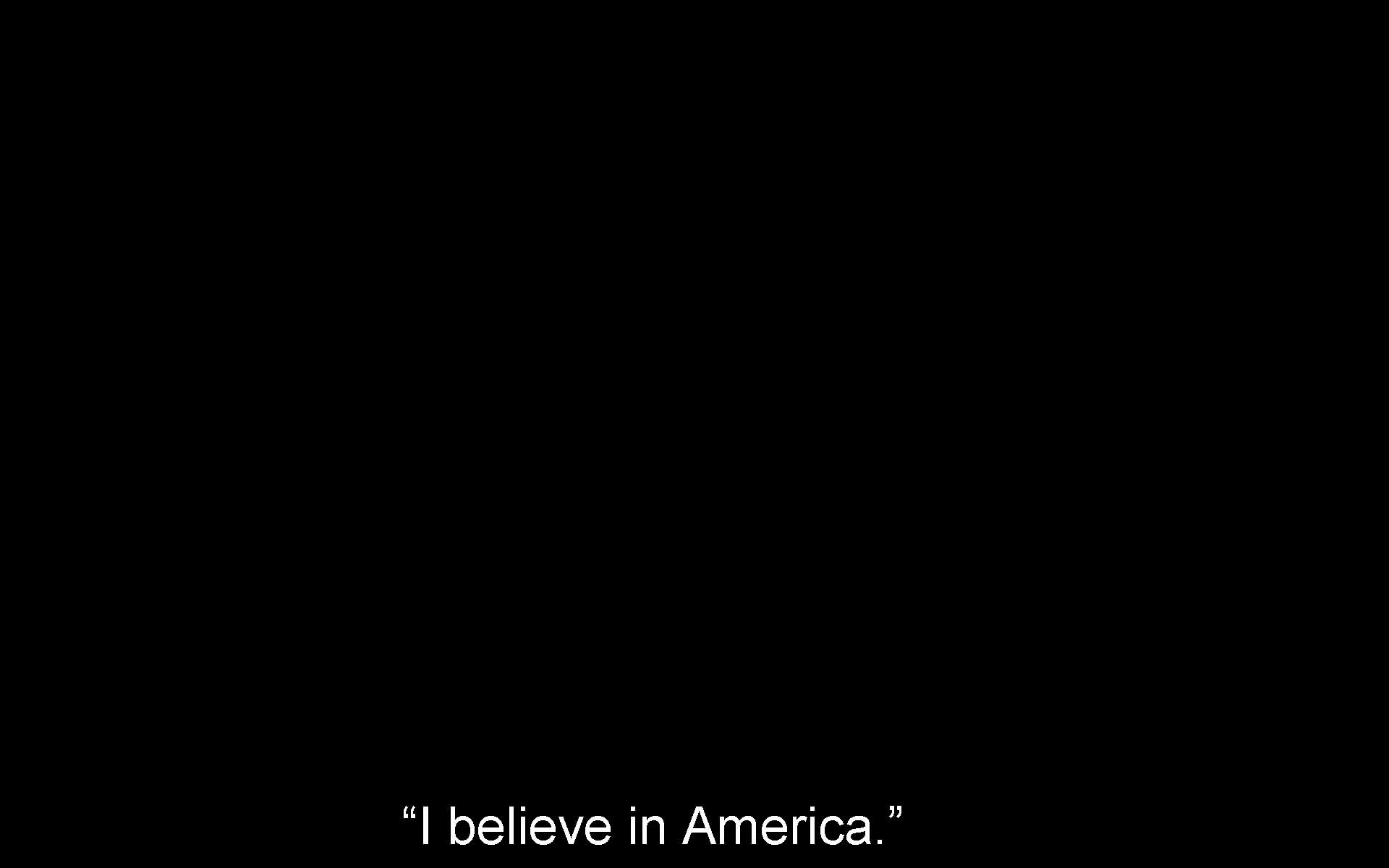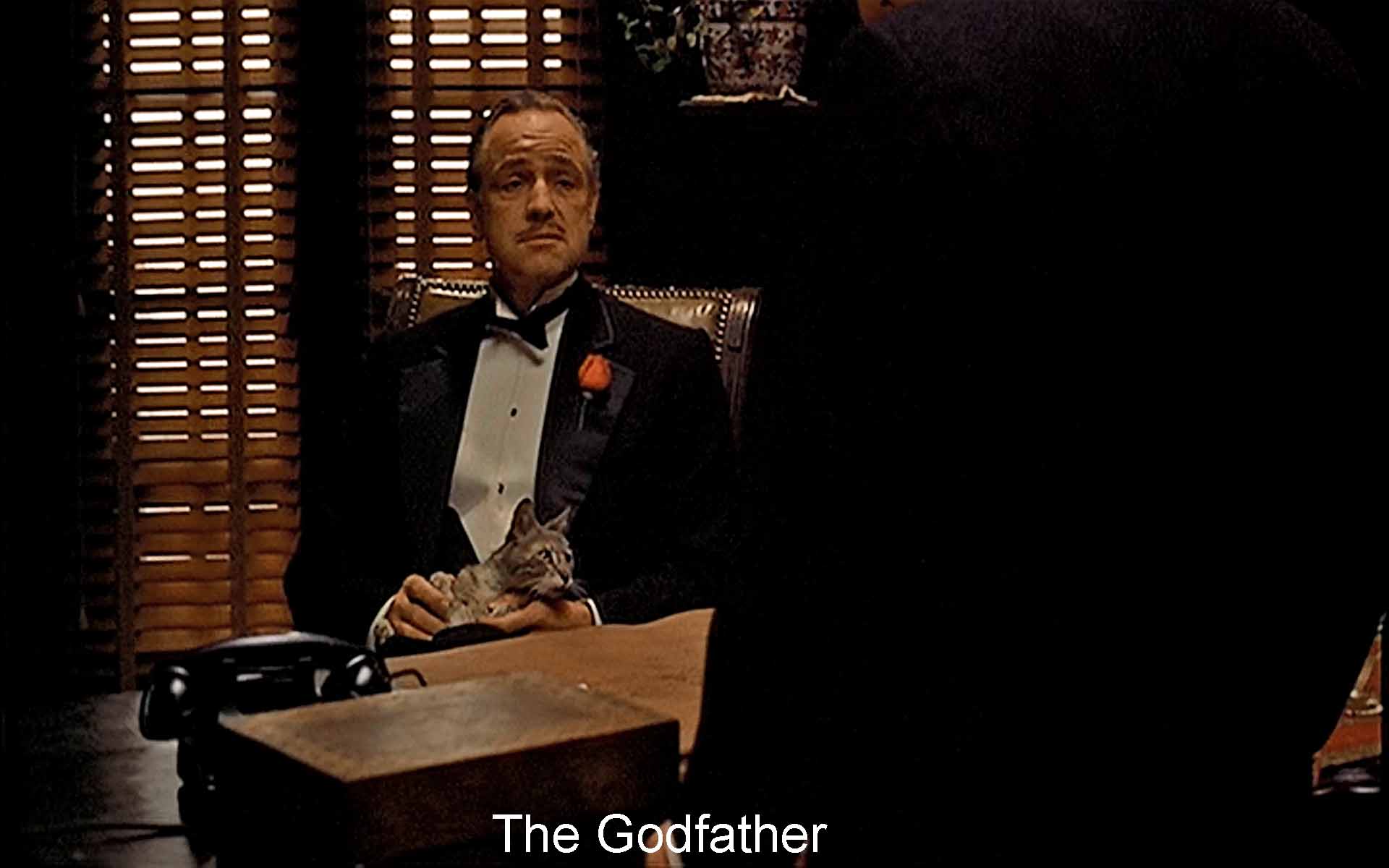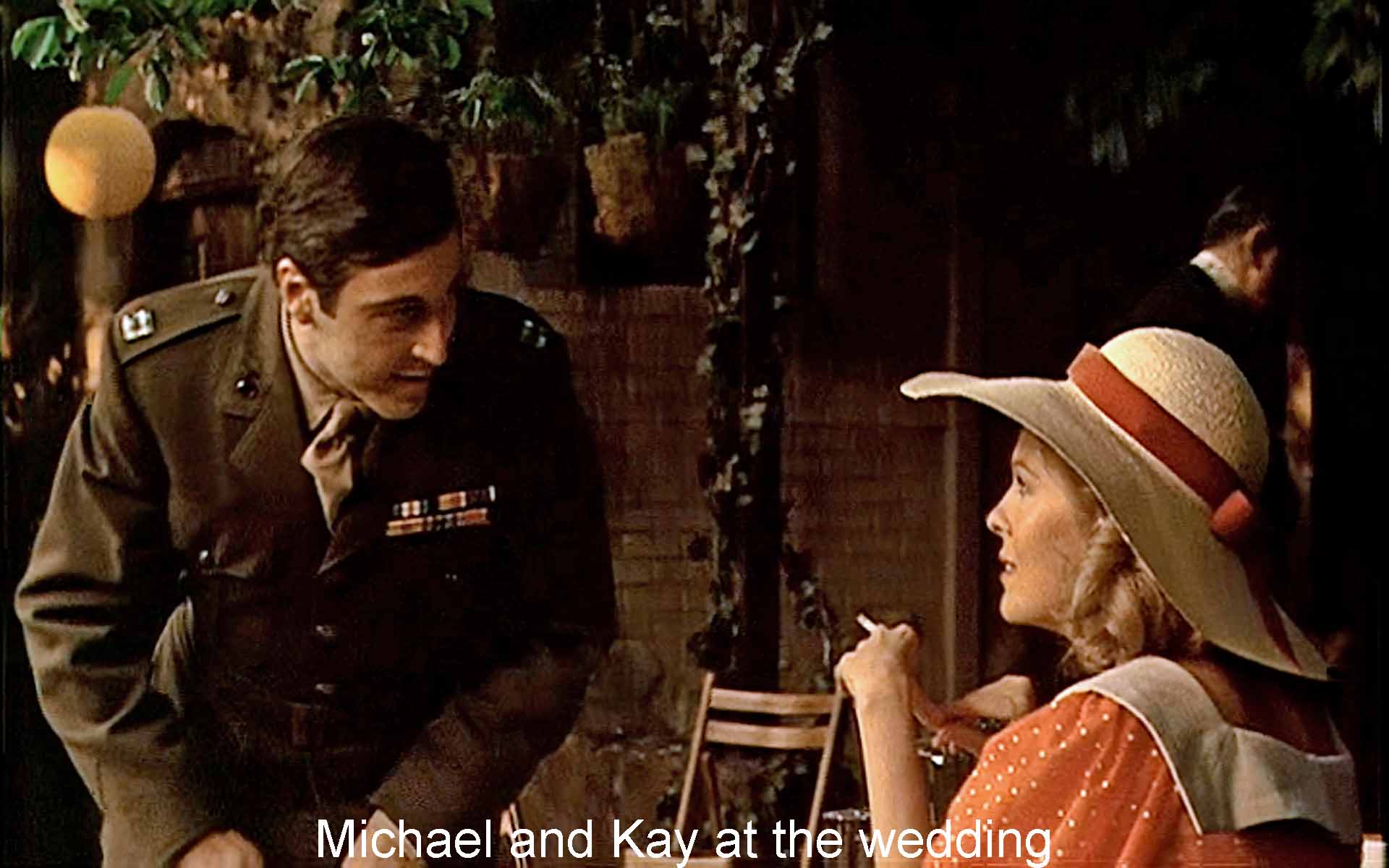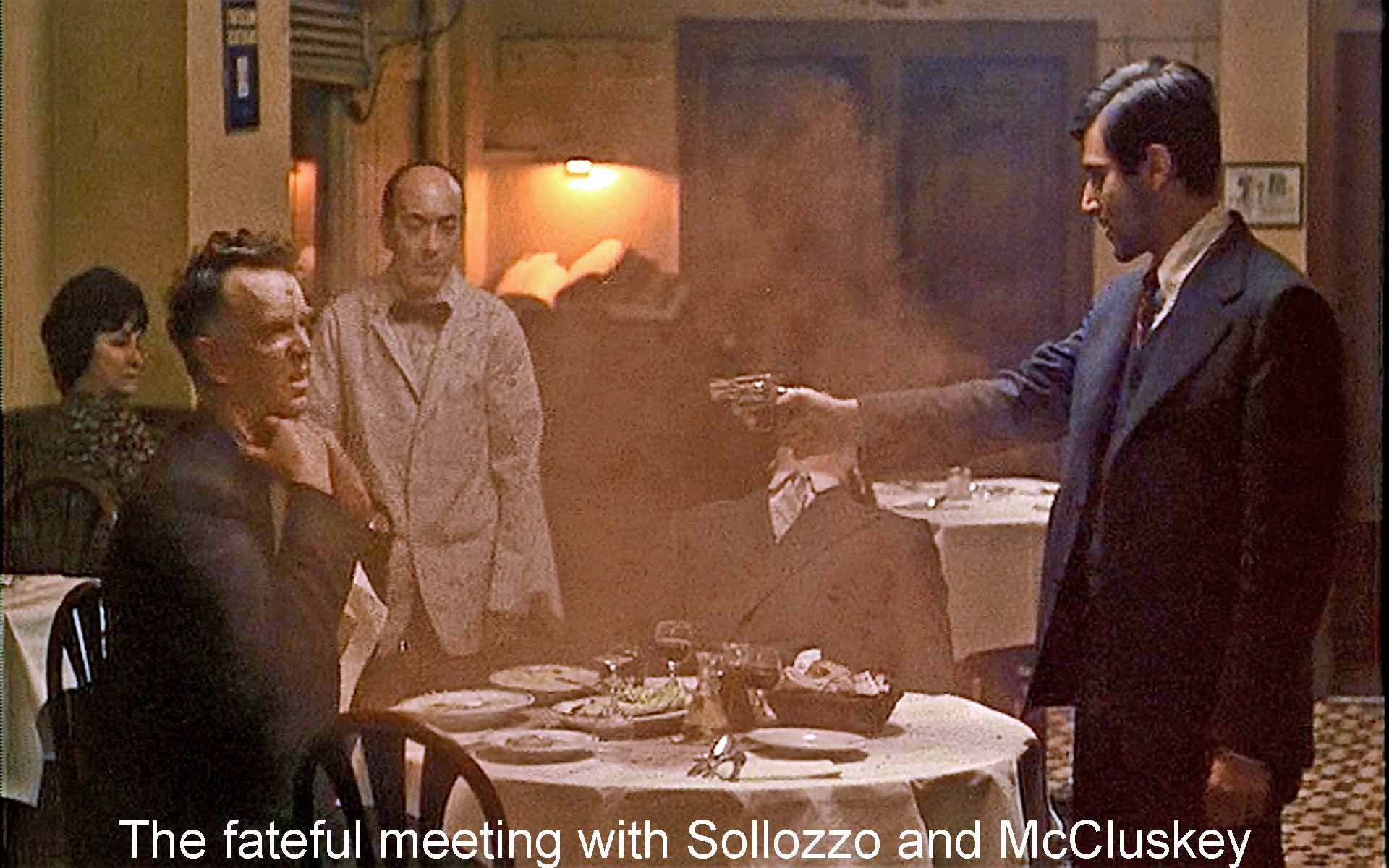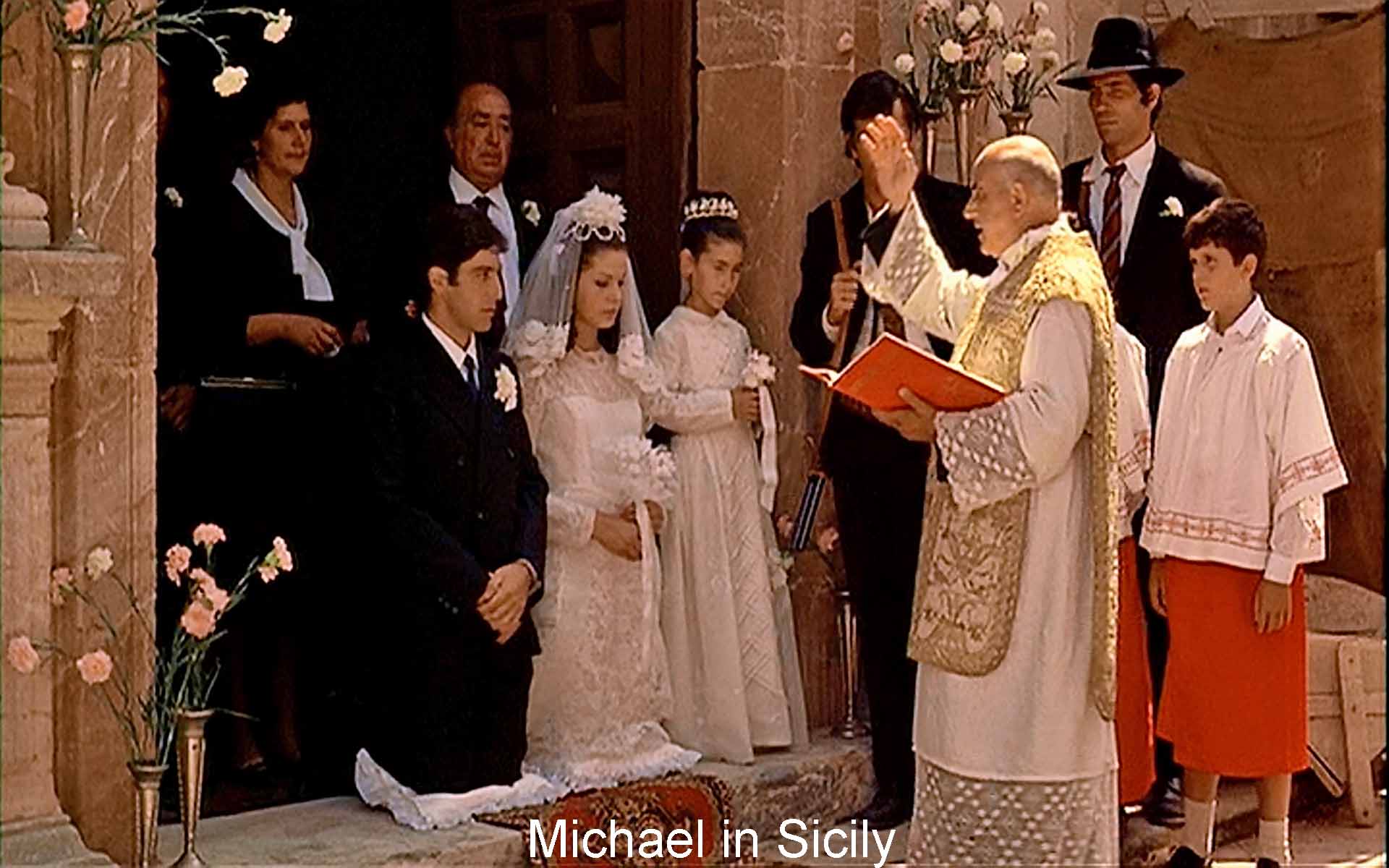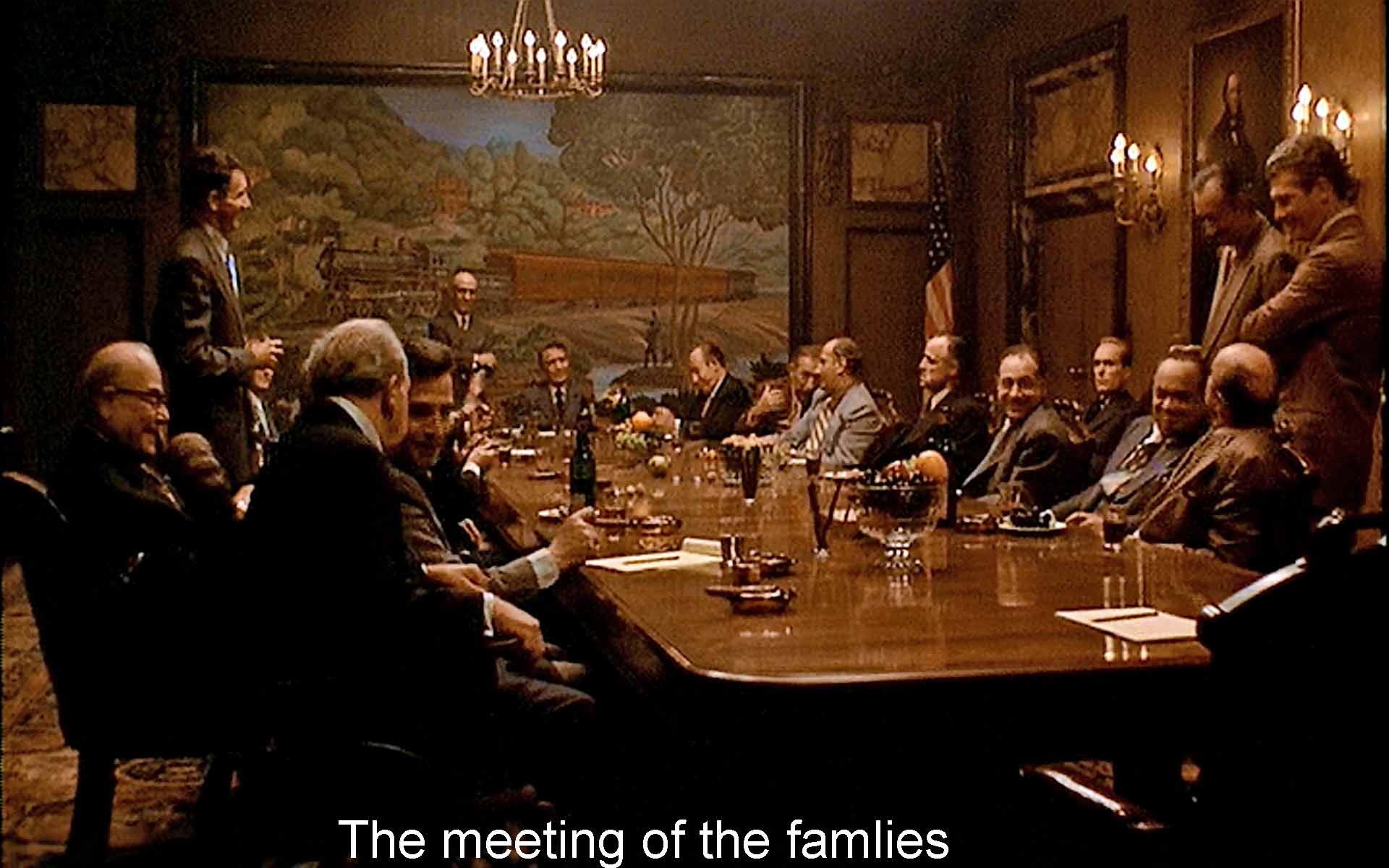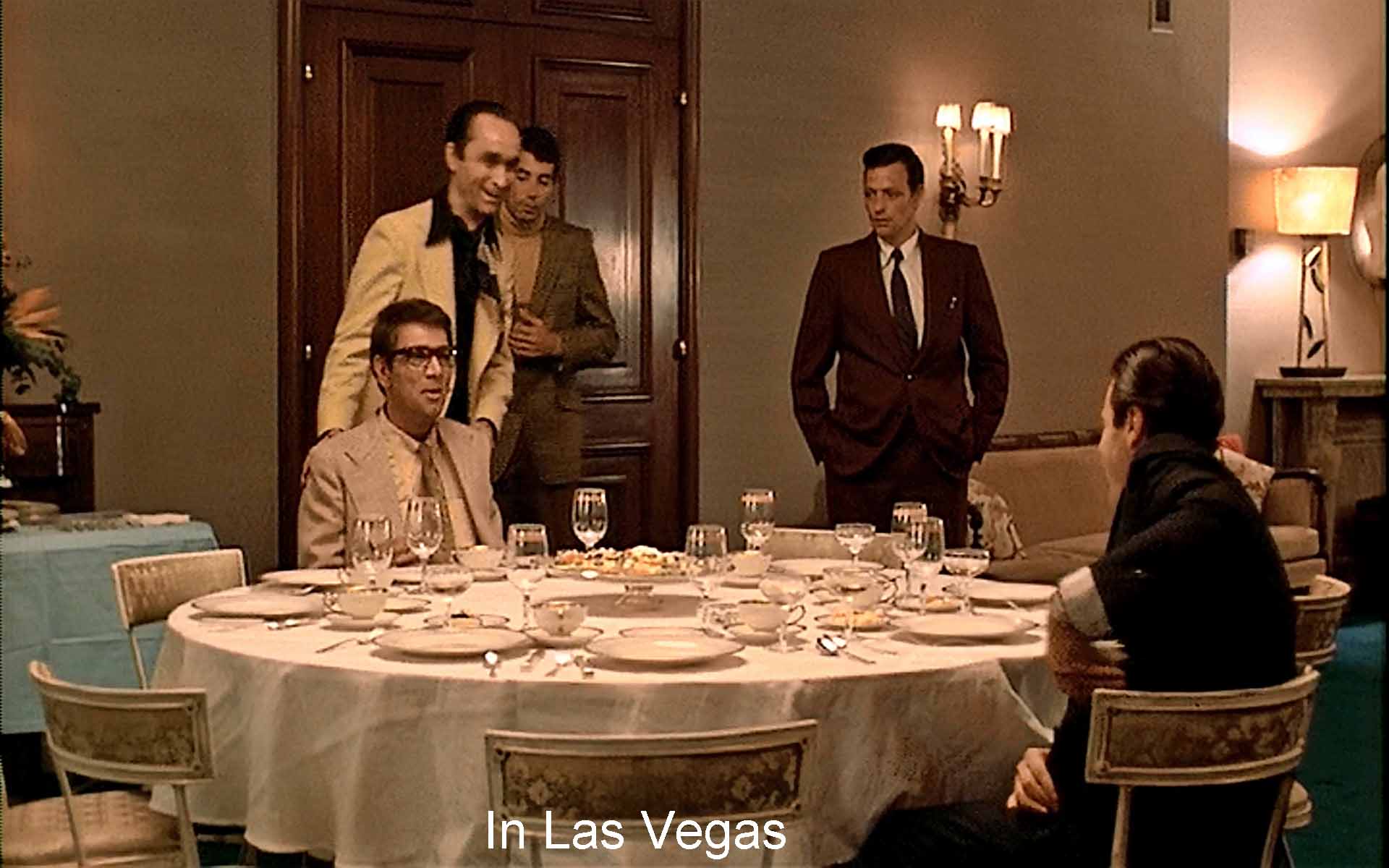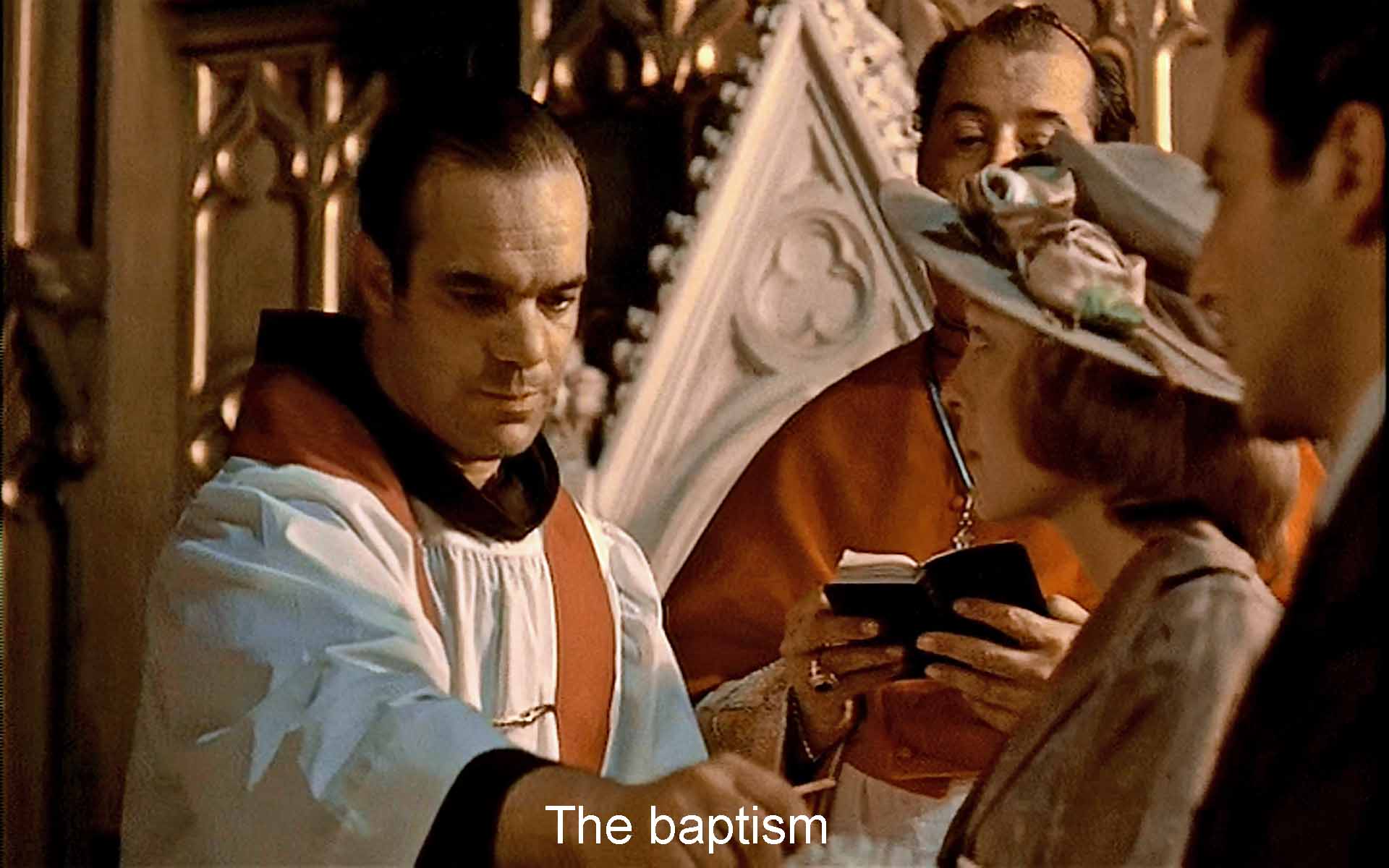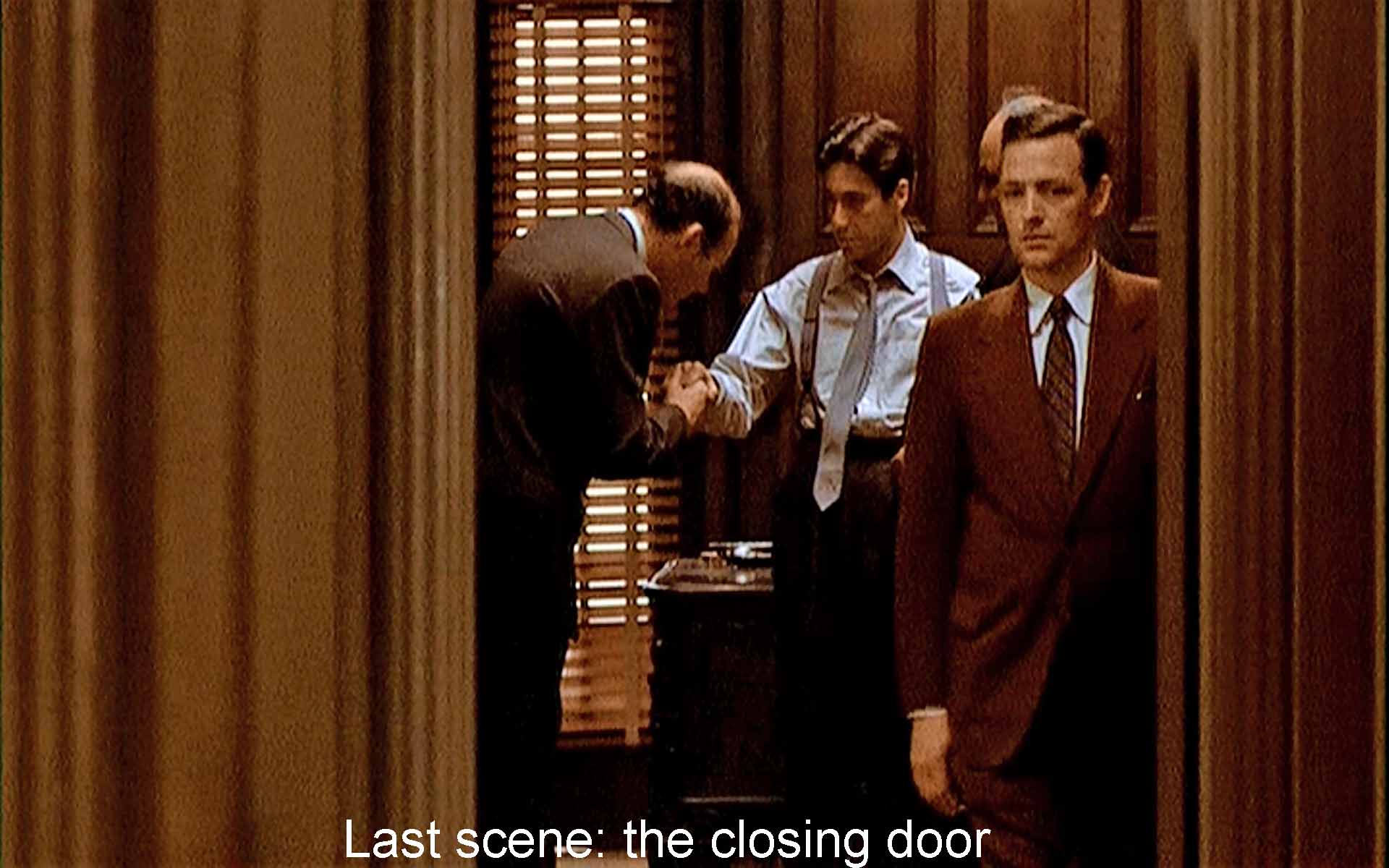”I believe in America.” The first line we hear resounds like the opening notes of an opera across the black screen that opens The Godfather. In his dark study, Don Vito Corleone (Marlon Brando) hears from petitioners. Tradition says that he cannot refuse them on this, the day of his daughter’s wedding. Outside all is sunshine, bright colors, music, dance, wine and merriment for the wedding of the Don’s daughter.
At the wedding we meet, barely, the bride and groom: Connie (Talia Shire) and Carlo Rizzi (Gianni Russo). More important are Vito Corleone’s three sons: Santino or Sonny (James Caan), the hot-tempered, adulterous eldest; Fredo (John Cazale), the weak, lecherous middle son; and Michael (Al Pacino), once a college boy, now a Marine captain and returned war hero (this is 1946). He is the one the Don wants to keep “legit,” clear of the family’s criminal “business.” And there is Tom Hagen (Robert Duvall), the Don’s adopted son and the consigliere (counsellor) to the “family,” that is, the “business.”
We also meet the Don’s two principal henchmen (capos), Clemenza (Richard Castellano) and Tessio (Abe Vigoda). We meet Kay (Diane Keaton), Michael’s very American girlfriend. She is puzzled by Luca Brasi (Lenny Montana), Vito Corleone’s not very bright enforcer, who stumbles through a speech of gratitude to his boss. And we meet Johnny Fontane (Al Martino) the Godfather’s godson and a famous crooner. He brings out shrieks of joy from the teenage girls at the wedding as he sings a love song to the bride.
Inside all this jollity is dark ritual as the Don arranges acts of violence and corruption: a measured revenge for a beaten-up daughter, a baker’s prospective son-in-law’s staying in this country, most importantly, getting for Johnny Fontane a movie part that he wants. This last culminates in the famous “horse scene” in which the recalcitrant movie producer Jack Woltz (John Marley) wakes up next to the severed head of his prize racehorse.
The action proper begins when Virgil Sollozzo (Al Lettieri), drug lord, tries to pressure Corleone (whose name means lion-heart) to back him financially and with the cops and judges and politicians he has “in his pocket.” The Don refuses and open war breaks out between the Corleones and Sollozzo backed by the Tattaglia family. They kill the Corleones’ strong man, Luca Brasi, and nearly kill the Don himself. Hot-headed Sonny, the oldest son, takes command and escalates the war. Michael (Al Pacino), until now out of the family business, agrees to meet with and shoot Sollozzo and the corrupt police Captain McCluskey (who aided a second attack on the Don). He does.
The war heats up still more. Michael escapes to Sicily, where he impulsively marries Apollonia (Simonetta Stefanelli). Fredo, the weak middle son, goes to Las Vegas. But the pro-drug faction uses Carlo as bait to kill Sonny in a hail of bullets, a scene derived from the final killing in Bonnie and Clyde (Penn, 1967). In Sicily, a car bomb destined for Michael kills Apollonia. Then Don Corleone meets with the other mafia bosses and agrees to some of their demands, negotiating a truce.
Old and weak, the Don makes Michael the head of the family. Now startlingly forceful, he finds Kay and they marry. He goes to Las Vegas to buy the rest of the casino, part of a plan to make the family legitimate in five years, a plan that will placate Kay. Back in New York, as he stands godfather (sic) at the christening of his nephew, Michael has all the heads of the Five Families who have opposed him gunned down plus a long-serving capo who has turned traitor plus Carlo who had set up Sonny. Then he denies responsibility for Carlo’s death to Kay and closes the door on “business” to her forever.
This is a marvelously complicated film, nearly three hours long. For brevity’s sake, I’ve given you a rather skimpy plot summary. You can find longer ones at these links, courtesy of Wikipedia and Turner Classic Movies. Best of all, see the movie before reading further.
That final door closing, is it a quotation of the door closing that ends The Searchers (Ford, 1956) shutting out the John Wayne character from “the family”? Who can know? Coppola has put so many brilliant touches in this film.
The film starts out with the Don’s asserting principles of morality and justice. He and his team are not murderers. But of course they are. He is finding his way thru a moral morass.
Coppola gets us to root for these killers by seeing the gangster life from the inside. We never see any of the prostitution, bootlegging, loansharking, extortion or “protection” that are the brutal, hurtful stock in trade of this “business,” things that destroy ordinary citizens. The only people the Corleones kill are more evil than themselves. The opening scene develops the Don as a man of principles and morals even if in an evil “business.”
The mafia made various efforts to block the filming, but when it appeared, real-life gangsters, some caught on FBI tapes, saw the film as accurately portraying their lives. Wikipedia quotes Sammy (”The Bull”) Gravano of the Gambino crime family, “Maybe it was fiction, but for me, then, that was our life. It was incredible. I remember talking to a multitude of guys, made guys, who felt exactly the same way.” Some mobsters, when testifying before a congressional committee, even imitated Brando’s hoarse, guttural voice, which he himself had imitated from Frank Costello’s testifying before a congressional committee.
As always with Coppola, family is an important theme, including his own: his sister, Talia Shire plays Connie in the trilogy; his mother, his father, and his two sons serve as extras; and his daughter Sofia, three weeks old, is the baby in the baptism. .
But the big theme in this picture is the two families. One is the gangster team, a family build on trust and respect and, indeed, affection. This business is a family unlike the indifference of the giant corporations that are the America the undertaker believes in. That indifference was what such prominent conservative economists as Milton Friedman, adviser to Ronald Reagan, advocated It is the core of American libertarianism, as contrasted to European. But this “business” with its bloodletting does not extend to wives and small children. (But it’s okay to kill grown sons in the “business.”)
And you don’t cheat on your wife. The Don says, to Johnny Fontane but intending it for Sonny, “A man who doesn’t spend time with his family can never be a real man.” And later he asks Michael if he is happy with his family, and we see Michael with Kay and his son. We see him serve as godfather at a baptism. Neither the Don nor Michael fool around with women on the side, and the film disrespects the philanderers who do, Sonny and Fredo and Tattaglia.
Another repeated Coppola theme is the journey. usually a journey of self-discovery and maturation. In this film it is Michael’s trip to Sicily where he finds his Sicilian nature. Then, in Las Vegas, he finds his strength and ruthlessness.. And he travels to New Hampshire to find Kay and persuade her to marry him. Like his father he now has his second “family.”
Reading about The Godfather, I came upon a superb essay by Judith Vogelsang, developing many of the remarkable details Coppola used to enrich his tale. For example,
Orange. Now you would think the appearance of oranges and the color orange would be happenstance, but there is no happenstance in a movie. As Coppola himself says in the DVD commentary, about an apparently trivial decision to put gravel on a pathway: “Every thing that gets put into a film, every thing that someone fights for really, finds its way into the essence of the movie in more ways than you can imagine.”
See how orange systematically marks things or people or situations that are bad for the Corleones: Tessio (later a traitor) tossing an orange at the wedding; oranges on the dinner table at Jack Woltz’; oranges at the fruit stand when the Don is shot; Fredo standing next to a basket of oranges in the Don’s sickroom at home; Carlo’s orange suit; bowls of oranges before the Corleones’ enemies at the truce conference; the old, weak Don looking at goldfish as he abdicates; his trick with the orange just before he dies. And, by the way, isn’t the dress Kay wears at the wedding orange?
Fish. Goldfish, as above, but a minor motif, there are fish on the doors Luca Brasi passes through to meet Tattaglia and Sollosi. His death is announced by the delivery of fishes and the famous line, “Luca Brasi sleeps with the fishes.” And the war begins.
Sicily. Or Italy. From the very first scene we are confronted with Sicilian customs balanced against “I believe in America.” Don Corleone, unlike the other mafiosi, represents classic Sicilian values: justice, honor, keeping one’s word, respect for tradition and religion, keeping women away from “business,” protecting women. When the Don insists that he is dispensing justice, he is harking back to the ancient tradition of the Sicilian mafia as protector of the peasants against invaders or a corrupt government. It is, of course, a tradition long gone (as we can see in Godfather II).
I am struck too by how similar the Don’s values and the values of these 1940s mafiosi are to the feudal code of the knights in Arthurian tales: casual killing of rivals, respect and protection for women, careful observation of Christian rituals. a feudal-oath bound loyalty to the liege lord. Theirs was a culture that demanded honor at all costs, as these 1940s mafiosi do. Remember, Corleone means lion-heart, as in Richard. Interestingly, as they found a model in medieval chivalry so today’s gangsta rappers reach across time and space to adopt “the way of the samurai.”
By contrast American values are represented by a justice system that failed the undertaker’s daughter, by the FBI snooping around the cars at the wedding, and by the cops, judges, and politicians that Don Corleone has “in his pocket” that are to be shared among the mafiosi like "nickels and dimes." Corrupt and brutal Capt. McCluskey is the only representative we actually see of American justice.
Sicily also represents what Shakespeareans call a “green world,” a place to which the characters escape and straighten out the mess created in and by the city or court. Midsummer Night’s Dream. As You Like It. Here it is while Michael is in Sicily when his father negotiates the truce that enables the Corleone family to triumph.
Ms. Vogelsang singles out fat Clemenza as the man who incorporates both Sicilian and American values. He can give Michael a cooking lesson in making spaghetti, but he can also plan the killing of Sollozzo and McCluskey. He can combine American and Italian values in his famous line, “Leave the gun. Take the cannolis.”
Automobiles. Surely they represent the quintessence of American culture. In The Godfather they are the omnipresent tools of “business,” used for all kinds of assassinations. Poor Apollonia is killed as she is trying to become American, to learn English and how to drive a car and failing at both.
Wine and water. Wine represents Italian values as when Clemenza guzzles from a pitcher of wine at the wedding. Water, including sweat and urine, is associated with American doings. Interestingly, of the two IV drips feeding into the Don in the hospital, one is red, one is clear.
The broken jaw. The first one we see is the Don’s jagged jawline. Then we learn that the undertaker’s daughter’s jaw was broken. And finally there is the spectacular breaking of Michael’s jaw by police Capt. McCluskey.
Thunder and Screech. Ms. Vogelsang points to a series of loud sounds like thunder, echoes, screams, high notes. She lists: the teenagers’ shrieking as Johnny Fontane appears; the screech of Tom Magen’s plane landing, thunder as Woltz wakes up and screams; many noises in the hospital scene. In Sicily Michael sees Apollonia and is hit “like a thunderbolt.” The bomb explodes, killing her. Connie screams when Carlo beats her. Later at the Five Families’ meeting, the Don lists things that might kill Michael, “like a bolt of lightning.”
The baptism. The water is American, but the Catholicism and the reverence for a tradition is Italian. The scene is famous: Coppola cross-cuts between Michael renouncing the devil and all his works and rapid shots of his assassins out killing the heads of the Five Families. Ms. Vogelsang notes that each of these scenes has been foreshadowed. Moe Green, killed while getting a massage, had been rubbed and patted by the servile Fredo. The Don calls Tattaglia a pimp, and he is shot in bed with a girl. Others are shot in an elevator so they will no longer “rise” against the Corleones. The master villain, Barzini, used a fake cop to set up the Don; Michael uses a fake cop to kill him.
This essay is long, involving detail after detail, and I’ve only scratched the surface with these motifs. I’ve not dealt with the unleashing in the 1970s of American capitalisme sauvage, the production history with the interlocked corruptions of the mafia and the studio execs, the cinematography, the handling of hundreds of extras and complicated location shots, the acting, the all too real issues of good and evil. I’ve not written about what seems to me the core issue of the film, How should one live in a world where every institution is corrupt?
Since 1972, critics and ordinary film lovers have come to appreciate more and more the fine artistry of the Godfather trilogy. The first two of the three rank up there with Citizen Kane and have elicited a dozen books and many, many articles. They are endlessly fascinating works of art.
